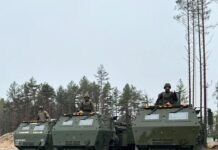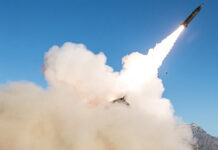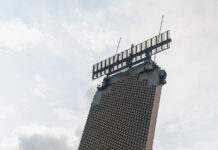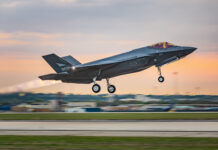This article discusses the origins of rocket artillery, describes its introduction to the modern battlefield, and explains why some were excited by the possibilities it offered while others rejected it. The article describes how many of the doubters of the utility of Multiple Rocket Launcher systems in the West changed their minds and suddenly became believers once they understood what was possible with these systems.
Defining Rocket Artillery
Rocket artillery, also known as Multiple Rocket Launcher (MRL) systems, has had mixed fortunes in Western militaries over the years, where the preference was for the accuracy of tube artillery to provide precision fires. In contrast, MRL systems were seen as a less discriminating and less accurate area weapon, hence the majority view being a preference for tube artillery rather than MRL artillery. Today, MRL systems have transformed the artillery picture, offering high levels of accuracy, vastly extended ranges and the ability to neutralise the complete spectrum of target types. Elsewhere, the attitude towards rocket artillery was much more positive. The Soviet Union was the pioneer in the operational use of MRL systems in the modern era. Subsequently, it invested heavily in further developing the operational capabilities of such systems.
Imitations
Inevitably, Soviet satellite states followed suit and also acquired MRL systems in numbers, both Soviet or local variations of prevailing MRL technology. States such as China and India also acquired Soviet MRL systems and this provided the basis for their own indigenous rocket artillery developments, more comprehensive in China than in India. Chinese MRL technology has also provided the basis for others to develop their own MRL systems
Other nations that have developed their own sophisticated MRL capabilities include Brazil, which is an excellent example of having exported their own MRL solutions. In terms of sophistication one should not ignore Israel, which having captured Soviet-origin MRL systems on the battlefield, went on to utilise them as a part of its own artillery arsenal, and then developed performance improvements, providing the basis for indigenous MRL programmes. Other nations have also developed and fielded MRL solutions, including, amongst others:
- Iran
- Japan
- South Korea
- South Africa
- Turkey
The fact of the matter is that a functional basic MRL system is not that difficult to develop. At that level, the technology required is not state-of-the-art. A 122 mm rocket with a High Explosive (HE) payload and reasonable performance is not going to pose that much of a technical challenge. Add in the launcher and place it on a truck chassis and you are good to go. In contrast, developing a viable tube artillery system is a very different level of difficulty, to the extent of being unachievable for many countries.
Single-Tube and Expedient Solutions
To complete the spectrum of rocket artillery utilisation, it is necessary to mention the use of artillery rockets by insurgents and non-state actors. A typical option in this regard is the single-tube GRAD-P launcher. This was developed in the mid-1960s, and initially had a 122 mm 9M-22M HEF rocket with a range of 11 km based on a tripod mount.
Another single-tube rocket system was developed in China, using the 107 mm rocket of their Type 63 MRL system. This was a 12-barrel system on a towed carriage. Subsequently, vehicle-mounted versions were developed. Initially, the 107 mm rocket had a range of some 8 km, with HE and HE-I ammunition natures available. Later on, new rockets were developed with a range out to 11 km, and these included an HE-F nature, a cargo round, even a rocket containing an electronic jammer and allegedly a rocket with a white phosphorous payload. It should be noted that these days, many other countries manufacture 107 mm rockets as well. The 107 mm rocket is particularly suitable for insurgents and other non-state actors as it can be successfully launched from virtually any apparatus. The Type 85 single-tube launcher is not a necessity in this regard, although using it makes the rocket more accurate.
Vietnam, Afghanistan and Iraq
The single-tube rocket system first became noticed during the Vietnam War, when the Viet Cong typically used 107 mm and 122 mm rockets to attack both military and civilian targets in South Vietnam. The Afghan Mujahideen were enthusiastic users of rocket systems with a wide variety of targets being attacked. In one case in 1986, a major Afghan Army ammunition dump outside Kabul was hit with a salvo of 107 mm rockets, triggering numerous secondary explosions and causing massive damage.
The use of artillery rockets in asymmetric conflicts would become a fact of life in Afghanistan post-2001 and Iraq post-2003. One very common rocket system encountered was originally intended for rocket pods used by aircraft and helicopters. This was the S-5 57 mm rocket. The rockets were then re-purposed to become expedient artillery rockets on a range of locally manufactured mounts, ranging from single-round to multiple launcher. The range of the rockets was short and in combination with all sorts of strange local mounts were as likely to injure the user as much as the target.
Improvisation
In Iraq, there were a whole array of rocket threats that were faced by Coalition Forces and the threats continue to evolve to this day challenging Iraqi security forces. Once the Iraqi Army collapsed after the fall of Baghdad in April 2003, there were vast stocks of unsecured munitions available that were acquired by insurgent groups, some loyal to the Saddam Hussein regime and some Islamist, Shia groups, tribal groupings and others who simply saw profit to be gained selling weapons and munitions.
There were examples of 240 mm calibre rockets used by insurgents. These were normally used with the truck-mounted BM-24 system. In Iraq, insurgents manufactured launchers for these 240 mm rockets. Accuracy would not be great but the destructive effect would be significant. Mention should also be made of Improvised Rocket Assisted Munitions (IRAM).
Here, a propane gas cylinder filled with C4 or another military grade explosive is attached to an artillery rocket, often 107 mm. In Iraq, a truck would be converted to carry rail launchers for the IRAM. The launchers and the IRAM would be hidden from view until the launch site was reached. The truck driver would then leave the vehicle and the rockets would be launched by a second person activating the system via cell phone. Once the rockets were launched, they would ignite flammable materials located on the truck bed. The truck would then catch fire and no evidence would be left to track down the perpetrators. The IRAM downside was limited range and poor accuracy, but get close enough to the target and these system have real destructive effect.
Countermeasures
In the main in Iraq and Afghanistan, the rocket threat was mainly centred on 107 mm and 122 mm systems, with variations coming into play depending on where the rockets were sourced from. As previously noted, initially most of the rockets were already in-country, then external suppliers came to the fore, for example with Iran supplying favoured groups in Iraq. The threat of rockets, with those of mortars and other artillery in Iraq and Afghanistan led to the development of Counter Rocket Artillery and Mortar (C-RAM) systems as a defensive measure to protect high value targets. Early C-RAM proposals flirted with laser technology, but the majority of C-RAM systems fielded thus far are based on naval CIWS technology, with one major exception of the form of the missile-based Israeli IRON DOME system.
Palestine
There was an obvious requirement for Israel to have a credible C-RAM solution as it faces a massive rocket threat from Hezbollah in the Lebanon and now also in Syria, plus Hamas and the Palestinian Islamic Jihad (PIJ) in Gaza. The Hezbollah rocket inventory ranges from Chinese 107 mm systems, Russian BM-21 122 mm and probably the BM-27 URAGAN 220 mm MRL system (likely via Iran or Syria).
On top of these capabilities, it also has a vast number of different Iranian artillery rocket types, including large calibre systems with ranges between 200 and 400 km. It is expected that Hezbollah could launch between 1,500 and 2,500 rockets a day against Israel in the event of a conflict, according to Israeli officials talking to Agence France-Presse (AFP) in October 2021, with large areas of Israel coming under threat. Back in 2006, when Hezbollah clashed with Israel, it would have taken a month for Hezbollah to launch the number of missiles that the Israelis now expect to be hit with in a single day.
In Gaza, both Hamas and the PIJ have access to rockets with Iranian types predominant, but both groups also manufacture their own rockets. As previously stated, building a basic rocket is not that much of a technological challenge. However, these ‘home-built’ rockets have their problems; range is short and performance is questionable. This explains incidences of rockets dropping short within Gaza or going off course. In May 2021, when Hamas and PIJ were firing rockets into Israel, some 400 were fired every day and of these more than 90 per cent were intercepted and destroyed by the IRON DOME system, according to a report by AFP.
Israeli Countermeasures
The intensity of the rocket threat in the Middle East is unlikely to reduce. For insurgents and non-state actors, the fact that there is now so much emphasis on C-RAM demonstrates what a powerful tool rockets can be. As reported by AFP in May 2021, the cities of Tel Aviv and Ashdod received the largest amount of incoming ordnance since the foundation of the state of Israel. Now consider what might happen in the event of Hezbollah unleashing its rocket arsenal. On the other hand, Israel has the IRON DOME system and shelters for its citizens, plus the means to rapidly target rocket launch sites and their supporting infrastructure.
The asymmetric wars of the post-2000 period have seen a major change in how the artillery rocket is viewed. Its significance has expanded from a weapon for use on the conventional battlefield to playing a role in a far more complex military environment. In the context of the Israeli situation, the artillery rocket has become the basis for a strategic threat. Furthermore, threat intensity continues to increase and this requires further investment in defensive countermeasures and defences – all of which goes to show that a relatively unsophisticated weapon system can have an effect far out of proportion to the investment needed to make it a threat.
Even so, no matter how much Hamas and PIJ boost their rocket capabilities they will never have enough rockets to make them a weapon of decision. For Hezbollah, their rocket arsenal is truly significant. The fact that they could launch 2,500 rockets in a day constitutes a massive threat. It is still not a weapon that could force a decision though, and it could not stop the inevitable and quite possibly decisive Israeli retaliation.
On the Battlefield
The roots of the modern MRL can be traced back to the 1930s and the Soviet Union where research into solid fuel rockets led to practical solutions in particular a 132 mm design. A 16-rail MRL launcher was then designed and mounted on a ZIS truck and this became the BM-13 KATYUSHA. It is estimated that only 40 BM-13 systems were completed before the Soviet Union was invaded on 22 June 1941. The first combat use of the system was on 14 July 1941 near Orsha, in what is today Belarus, when a battery of BM-13 commanded by a Captain Flërov engaged the enemy reporting highly satisfactory results. Depending on the rocket type used, the range for the BM-13 was between 7,900 metres and 11,800 metres.
Unsurprisingly, there were negatives with these early MRL systems, including range limitations and rocket dispersion. Of course, if you had enough MRL systems, the weight of the salvo more than made up for dispersion and as larger calibre rockets were fielded, salvo density rose dramatically increasing on-target effects. Outside of the Soviet Union, others were impressed with the potential of the MRL system and most of the major combatants fielded artillery rocket systems of various natures.
Post-War Innovations
Post 1945, the Soviet Union introduced a new MRL generation with higher performance, but it was in the early 1960s that they introduced an MRL system that was arguably one of the most influential systems of its type in the modern era; that system was the BM-21 GRAD. During the current Russian invasion of the Ukraine, nearly 60 years after it entered service, the BM-21 is being used in combat by both Russian and Ukrainian forces.
The standard BM-21 is a truck-mounted system, initially a Ural 375D, with the launcher having 40 rocket tubes for 122 mm rockets. The capability evolution of MRL systems is demonstrated by the fact that, according to Soviet data, in comparison to the BM-13 of the 1940s, the BM-21 had four times the salvo weight and eight times the total destructive capacity! Initially, the BM-21 rocket had a range of 20 km, though more recent rockets have ranges in excess of 40 km. Rocket natures include HE-F, anti-tank mine, smoke, sub-munition and RF jammer. Apart from countries in the former Soviet space, countries that have manufactured the BM-21 include:
- China
- Egypt
- Ethiopia
- Iran
- North Korea
- Pakistan
Western Responses
Western responses to Soviet MRL systems were limited, though there were exceptions. Germany introduced the Light Artillery Rocket System (LARS) into service at the end of the 1960s; this was a 36-tube 110 mm calibre MRL. An upgraded version of LARS-2 on a new MAN truck chassis was introduced in the early 1980s. However, there was an attempt at a more ambitious project known as RS-80, which involved Germany, Italy and the UK. This was a six-tube 280 mm calibre MRL mounted on a LEOPARD 1 chassis, with the rockets having a range of between 40 and 60 km. The British withdrew from the project in 1975 after they could not convince the other two partners of their preference for rocket accuracy and the programme then ground to a halt.
The NATO Solution
In the mid-1970s, the US Army changed its mind about MRL systems and generated a requirement known as the General Support Rocket System (GRS), which later became the M270 Multiple Launch Rocket System (MLRS) which entered service in 1983. In Europe, the MLRS was acquired by:
- Denmark
- France
- Germany
- Greece
- Italy
- The Netherlands
- Norway
- Turkey
- The UK
Later, both Denmark and the Netherlands sold their MLRS to Finland, while Norway retired its systems.
MLRS continues to be the NATO rocket artillery system of choice and it will be in service for many years to come, as evidenced by an ongoing British Army MLRS upgrade programme. At the end of March 2021, it was announced that an agreement had been reached with the US Department of Defense (DoD) covering a five year programme to upgrade 44 British MLRS launchers. Work will commence in March 2022 and will be carried out at the Red River Army depot and at the Lockheed Martin Camden, Arkansas, facility, the work is included in existing production contracts between the UK and Lockheed Martin.
Future British Deep Fires
The upgrade will take five years to complete and the resulting M270B1 will provide the British Army Land Deep Fires capability until 2050. The upgrade will include:
- a new armoured cab
- upgraded automotive and launch mechanism components
- Composite Rubber Tracks (CRT)
- a vehicle camera and radar system will be added
A new Fire Control System (FCS) will be developed collaboratively with the US, UK, Italy, and Finland.
Chosen Ammunition
The upgraded MLRS will utilise the Guided MLRS Extended Range (GMLRS-ER) missile which should be in service from 2025 and will increase engagement ranges from the current 84 km out to 150 km. The other new weapon system that can be employed is Lockheed Martin’s Precision Strike Missile (PrSM) that is expected to be in service from 2024 and this offers a range from 60 km out to more than 499 km.
The PrSM was developed to meet a US Army requirement for a 499 km range weapon to replace non-insensitive and cluster munition versions of the Army MGM-140 Army Tactical Missile System (ATACMS), a 300 km range system. It should be noted that the 499 km range was the result of the 1987 Intermediate-Range Nuclear Forces (INF) Treaty that limited land-based ballistic missiles, cruise missiles, and missile launchers with ranges above 500 km. However, the US withdrew from the INF Treaty in February 2019.
Going Forward
The future of the MRL system is quite clear from the upgrade to the British M270B1 MLRS force, as the objective is long-range high precision deep fires. The HIMARS truck-based MRL system will also be capable of using the PrSM rocket system, further expanding its utility. Elsewhere, others are looking at their own deep fires solutions, for example Iran is said to have fielded a rocket with a range in excess of 600 km! The only drawback with these extended range systems is being able to achieve accurate targeting for these deep fires systems.
Elsewhere, the artillery rocket will continue to be an attractive means of firepower for insurgents/non-state actors. Ideally these groups would look to be supplied with rockets from external sources, but if that is not possible the ease of building rockets from locally available materials as demonstrated by Hamas and PIJ in Gaza makes them ideal weapons. All of which sees the artillery rocket having a long-term future in both conventional and asymmetric conflicts.






![Air-to-ground precision munitions: A market overview A SPEAR 3 test missile strikes its target during the first live fire test on 17 November 2024. [Crown Copyright 2024]](https://euro-sd.com/wp-content/uploads/2025/06/SPEAR_mini-cruise_missile_first_guided_firing__MBDA_2-Kopie-218x150.jpg)






